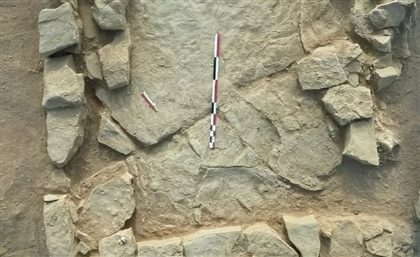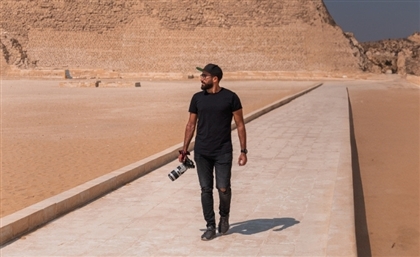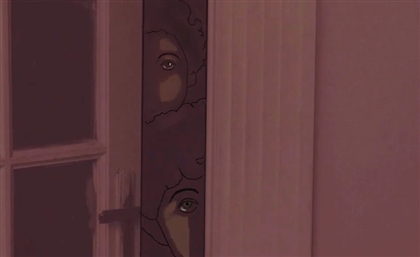Where Arabian Dinosaurs & Mammoths Roam: Inside Abu Dhabi's New Museum
Ahead of its public opening on November 22nd, 2025, the museum invited SceneTraveller’s Layan Adham Ismail to take a first look at its cosmic and prehistoric wonders.

When life is measured in weekends, summers, and elaborate birthday parties, it becomes difficult to grasp a number like 13.8 billion years.
That’s when the very first ember of anything and everything began to glimmer in the cosmos. When our universe, with all its stars, seas, and shawarma shops, was born. Yet, between its conception and its current form, lie countless creatures of both giant and microscopic proportions, ones we would have no hope of domesticating—or entrapping in Instagrammable enclosures—today.
What would our reality have been like, do you think, had dinosaurs roamed alongside Range Rovers? Had we encountered prehistoric elephants, would their tusks have been danger, or décor?
Questions
many a Hollywood blockbuster—and impassioned high school nerd—has tried to
answer. For
generations, we’ve watched American scientists, archaeologists, and clumsy
civilians evade the grasps of T-Rexes and Velociraptors. And, if our curiosity
managed to linger past the theatre, we journeyed to New York or London, just to
stand below a mammoth display and feel closer to an answer.
Yet,
throughout it all, we never stopped to wonder if our region, if our ridiculously
overlooked slice of the globe, was part of the story. Until now.
In
Abu Dhabi, where extensions of the world’s greatest museums share an island
with the Emirates’ own monuments to culture, our cosmic, Jurassic, and
prehistoric tales find a willing (and quite handsome) author in the newly
opened Natural History Museum.
 Natural History Museum Abu Dhabi Building (Designed by Mecanoo)
Natural History Museum Abu Dhabi Building (Designed by Mecanoo)
Constructed
of Tetris-like blocks of life, the museum’s jagged structure was designed by Dutch
architecture firm Mecanoo. It almost dares you to give in to human impulsivity, and
parkour your way to the top. On the ground, sculpted creatures peer from behind
vegetation. Vines dangle from geometric stone. And metallic paw prints guide
you through winding wadi-esque paths to the entrance.
Now, there’s
a moment, a humbling one, when you’re faced with a structure so magnanimous,
time seems to stand still. A tower that scrapes the sky. A vessel many may deem
unsinkable. Or
a congregation of dinosaurs—towering, theatrically backlit—welcoming you as you
step inside.
Here, it’s recommended to stop and relish in the fact that this is just the beginning.
 Brydes Whale
Brydes Whale
Your
designated tour guide beckons you over with the wave of a colour-coded flag,
and just like that, you descend into the depths via escalator, while skeletal creatures dangle from the ceiling beside you. Organized around a
central courtyard where crocodiles reign supreme, the galleries below trace the
universe’s story arc—from birth to present ailment.
Past an immersive recreation of the sky on the night the UAE first marked its place on the world’s map, you’ll find cosmic relics that show life as it was taking its first steps. Pieces of the moon that you can touch. And the uncontended star of the cosmic clan: the Murchison Meteorite. Discovered in Australia in 1969, this extraterrestrial rock carries the oldest materials ever dated on Earth—fragments of a universe that predates our planet by billions of years.
 Ash Shaqqah 002 Meteorite
Ash Shaqqah 002 Meteorite
Now, while this specific meteorite is revered for its contributions to
earth’s inhabitants, other far larger and less democratic meteors were, in
fact, the cause of life’s destruction. The next galleries showcase the natural
worlds and reigning families that ended because of unforgiving rocks: fanged, fish-like
giants. Insects the size of a six-year-old boy. Clams that would barely fit
inside a Husky’s mouth. The cosmic cycle seemed inevitable—life was always to
remain short.
Until one particular lineage, a resilient and roaring kind, managed to outlast them all, racking up so many years of existence, its remains now occupy the museum’s largest gallery: the dinosaurs.
 March of the Triceratops
March of the Triceratops
A vast collection of predators and prey from the Jurassic era, their
bones positioned in scenes worthy of Tony Awards, guide you to the museum’s
crowing curatorial jewel—two T-Rexes locked in a vicious battle over a fallen Triceratops. A cinematic
display of a world we would have had no hope of surviving, something that
becomes evident when you realize a juicy steak just about your size could
comfortably fit in either of their mouths.
Stan, famous
for being bitten on the back of his skull by one of his own kind, is shadowed
by a newcomer on the survival scene—a yet-to-be-named T-Rex that’s considered
one of the most well-preserved in the world, with bitemarks still visible across
its massive body.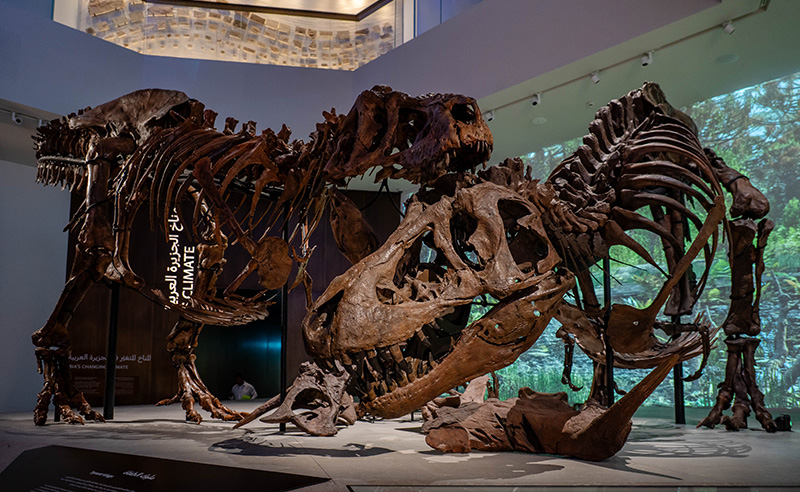 Tyrannosaurus Rex Skeletons
Tyrannosaurus Rex Skeletons
When you’re
face to face with THE apex predator, it’s difficult to imagine it could have
ever trembled, let alone fallen. Yet, as humans have come to learn again and
again but insist on forgetting, history has a way of repeating itself. And
also: meteors can be quite ruthless.
Felled by a cosmic event of unimaginable scale (pretty much the size of New York City) the dinosaurs’ reign ended, quickly and mercilessly, making way for new giants of land and sea. Within the galleries, this translates to: the appropriately named Stegotetrabelodon emiratus, a four-tusked elephant species that once roamed the Arabian Peninsula. The 25-metre skeleton of a modern-day Blue Whale, the biggest creature to have ever existed. And an incomprehensibly massive collection of taxidermied titans of today.
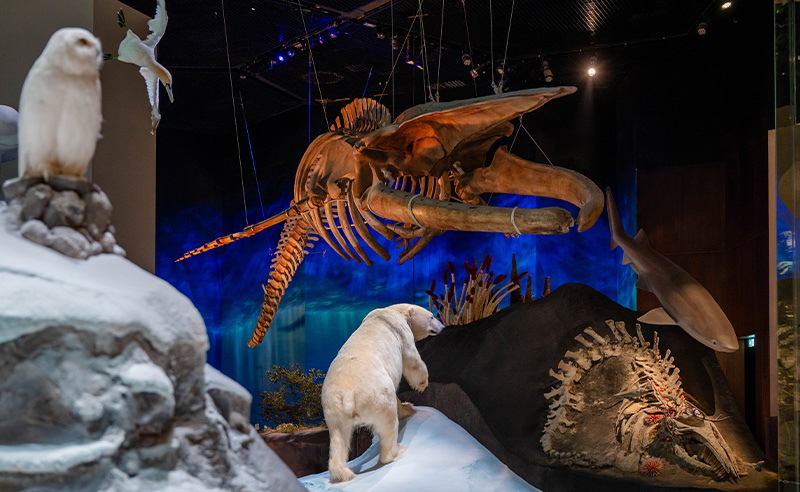 Blue Whale Skeleton (Balaenoptera Musculus)
Blue Whale Skeleton (Balaenoptera Musculus)
As the tour concludes with a poignant
(big) bang, holding up a mirror to society and its ongoing mistreatment of
nature, you begin to fully feel the sweep of existence. Everything you
witnessed, from the universe’s first breath to the delicate threads that
connect people and planet, serves to send one singular message: we are not
invincible. Our world, along with its friendly faces and falafel places, might
end. And there might be nothing to do about it. But the question is: will it
end because of a moody meteor, or because we fed it our most ferocious poison?
I would end on this sobering and existential note, but, as it turns out, there are a few things you could do: pick up one of the museum’s VR tablets and find out more about the 2,600 specimens on display. Then, pass that healthy curiosity on to the kids by dropping them off at the discovery areas and hands-on zones. While you’re at it, enroll them in some workshops. Or, at the very least, grab them a dinosaur plushie on your way out.
What good will it do?
The hope is that you, and those that
come after you, nurture that initial spark of wonder into a budding friendship.
Then that blooms into love, which readies the heart for devotion. Once the bond
is only breakable by a Cairo-sized meteor, you will never be able to harm the
earth again.
Trending This Week
-
Dec 12, 2025









